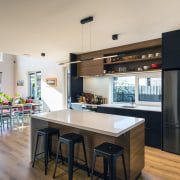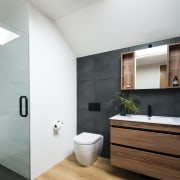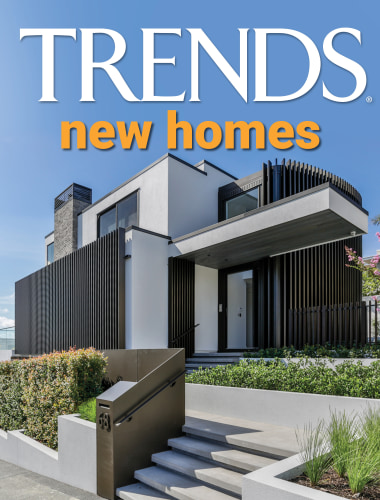Looking to the future
Despite a wall of windows stretching up into the gabled roof form at the rear, this home has strong green credentials and adaptable spaces for future needs
Designed by Shizuka Yasui and Bob Burnett, Bob Burnett Architecture
From the building designer:
The setting
The mature, native trees of Riccarton Bush serve as the backdrop for this striking, forward-looking three bedroom home designed to Superhome (a healthy homes movement) standards.
Situated in a leafy neighbourhood well connected to parks and restaurants, this spatially efficient and environmentally responsible home enhances the owner’s lifestyle with adaptable spaces for future needs.
The narrow nature of the site, with its north to south orientation, has influenced the bold, asymmetrical gable form and dramatic double-height living space.
The design
The contrast of dark aluminium and richly stained, Siberian Larch ensure the progressive home stands out amongst the traditional weatherboard villas while the proportions and gable roof pay homage to the longstanding character of the area.
Timber screening softens and directs the approach to the home while securing the bike storage.
This treatment is repeated on the opposite side to diffuse the threshold between house and garden and provide essential shading in summer.
At the entrance and double height living space, plywood ceilings continue seamlessly out to the soffits to draw in the outdoors.
A thoughtful layout ensures there is no wasted space and features a variety of diverse spaces for everyone to enjoy their own activities.
A cosy window nook on the stair landing provides a quiet spot with morning sun for reading or studying, while hidden Shoji screens to the multi-function room open up to the living/kitchen/dining for gatherings or close it off to maximise relaxation.
An alcove connected to the social, open-plan space accommodates the owner’s classic pinball machine.
Green thinking
The brief was for a comfortable, high performance, low emissions home that would greatly exceed the building code and be adaptable for future use.
Built to Superhome Healthy Home recommendations the home features slab-edge insulation, minimised thermal bridging, super-insulated Ecopanel walls, airtightness (1 air change/hr), and a mechanical heat recovery ventilation system.
In addition to the high-performance thermal envelope, solar panels linked to the hot water and underfloor heating have allowed for extremely low power bills.
An autumn power bill is between $3 – $5 per month.
Timber structure has been prioritised over steel to help reduce the carbon footprint, and the single steel portal frame has been positioned inside the thermal envelope to eliminate thermal bridging.
Recessed, thermally broken windows have argon filled, low-E Xtreme glass, which is a new, ultra-high performance double glazing that further improves the energy efficiency of the windows which are the weakest point thermally in a dwelling.
The study on the lower floor is set back into the form of the building to give this a secluded feel and minimise overheating from the west, while additional storage makes clever use of the extra space below the window.
The site was restricted by a flood management area and height restrictions, which has influenced the form.
With the narrow part of the site facing north, the solution was to open up the northern face with a gable form and double height living area to allow light to enter deep into the home.
Credit list
Building designer
Kitchen designer
Interior designer
Roof
Joinery
Paint
Feature light fittings
Builder
Kitchen manufacturer
Cladding
Windows
Flooring
General heating
Awards
Home kitchen bathroom commercial design
Connected to the ocean
Masculine meets mixed use
Contrast and connection

















